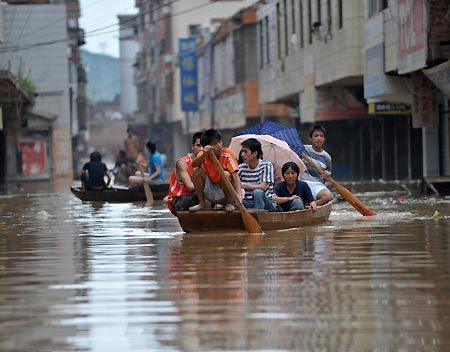Heavy rain and floods have claimed 171 lives in south China, and the forecast for the north is not bright either, with the government warning of serious flooding in the Yellow River.

Local people row boats in flooded Daoshui Town of Wuzhou City, southwest China's Guangxi Zhuang Autonomous Region, June 16, 2008. As of Monday evening, flood has affected 92 counties, cities and regions in Guangxi. Some 7.54 million people were plagued by the flood with direct economic loss standing at about 4.6 billion RMB yuan (US$660 million).
The worst storms and floods in decades have hit about 38.56 million people in 20 provinces, mostly in the south, the Ministry of Civil Affairs said yesterday.
About 52 people are missing and 2.2 million hectares of farmland has been inundated, the ministry said. The direct economic loss has reached 26 billion yuan ($3.3 billion).
Threat of massive floods along the 5,500-km Yellow River that runs through the north looms large, the China Meteorological Administration (CMA) warned yesterday.
Heavy rain in the next few days could "increase the destructive force of floods and make relief and rescue work even more difficult", the CMA said.
"National flood prevention and relief efforts are entering a crucial phase" because torrential rain are likely to raise the threat of floods in the lower and middle reaches of the Yellow River in Shanxi, Shaanxi, Henan and Shandong provinces, it said.
The Yellow River, China's longest after the Yangtze, has caused massive floods in the past but its devastating effects have not been felt in recent decades.
Weather forecasts warn fresh storms could lash parts of the Yangtze River delta and parts of provinces in the east, south and southwest too.
Vice-PremierHui Liangyusaid the fight against floods in South China had reached a critical stage. Hui is commander-in-chief of the country's drought- and flood-prevention headquarters too.
He told an urgent meeting yesterday that all related departments and local authorities in South China should fully realize the importance of fighting floods this year.
Twelve provinces and regions in the south have been lashed by heavy rain since June 7, with some areas experiencing the heaviest rainfall in 100 years.
Many rivers are already flowing above the danger levels and have broken their banks at some places in Guangdong province.
Many areas along the Xijiang River and the Beijiang River, tributaries of the Pearl River that runs through Guangxi, Hunan and Guangdong provinces, are under water.
The flooded Xijiang and Beijiang rivers pose a flood threat at their convergence point in Sanshui, Foshan city, where the water level hit the highest in five decades, Guangdong water resource department said.
At noon yesterday, the water level at Makou hydrological station in Sanshui was 8.4 m, almost 1 m above the danger level.
A Guangdong water resource department official said 18,000 relief and rescue workers had been mobilized to monitor the flood situation in Sanshui.
The floodgates of two dams in Sanshui were opened to discharge water and reduce the threat to the dam, Yue said.
About 20 people have been killed and more than 5.76 million affected by the floods in 17 of Guangdong's 21 cities, where food too, is in short supply.
According to official estimates, the province has already suffered an economic loss of 3.8 billion yuan ($540 million).
Heavy rain is likely to continue in Hunan and Guizhou provinces and the Guangxi Zhuang autonomous region during the next couple of days, the CMA said.